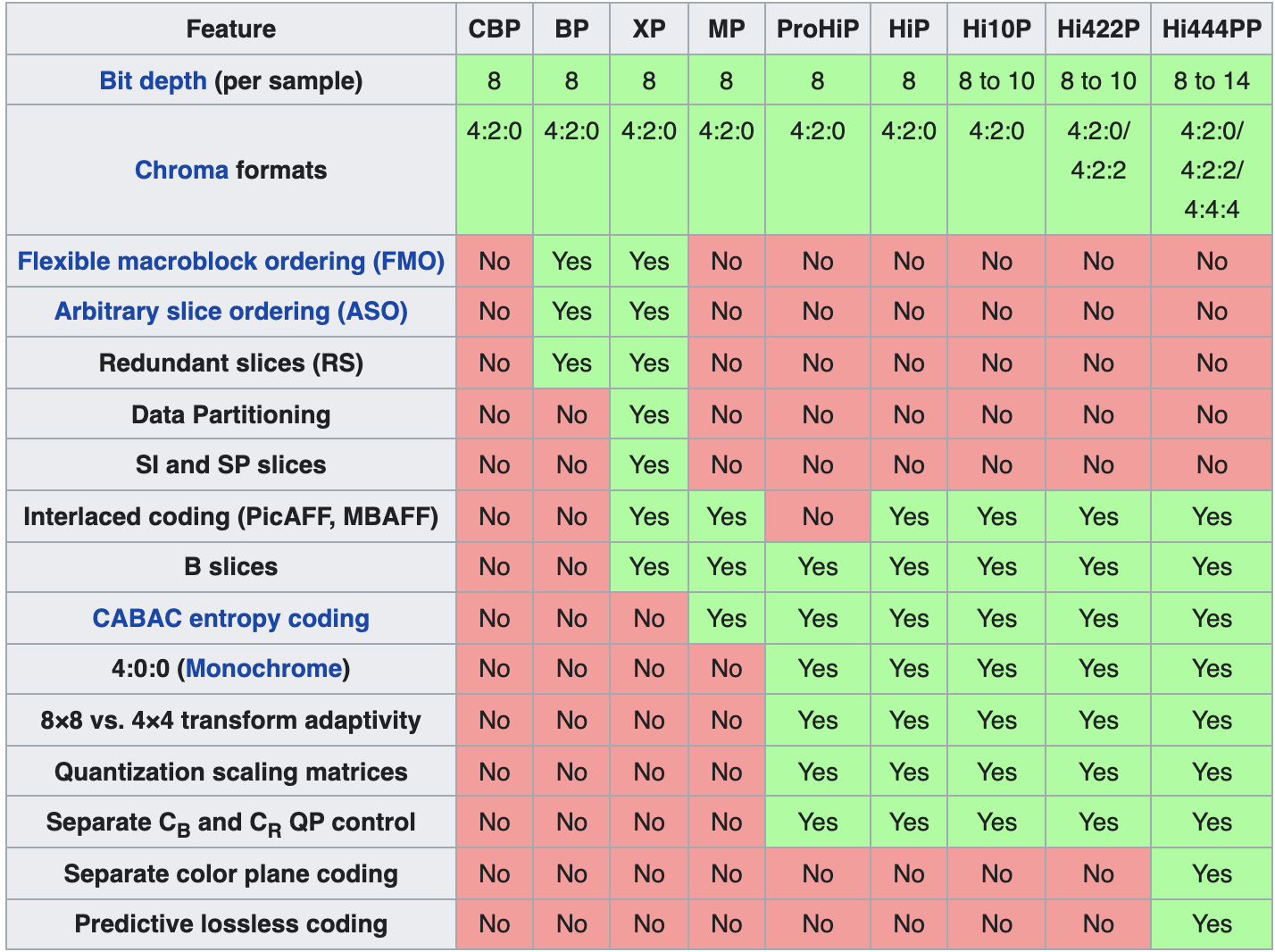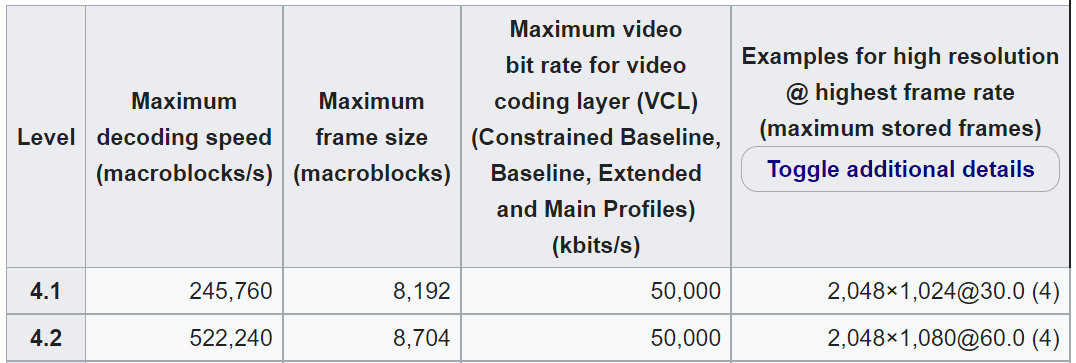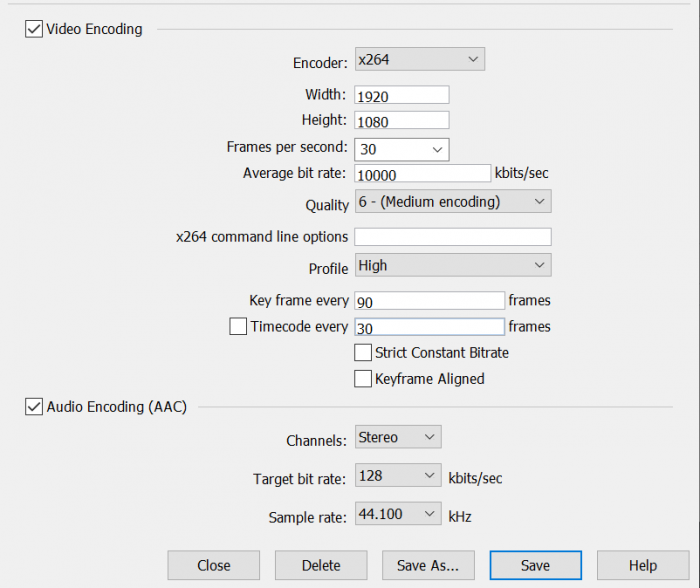H.264 Codec: Advanced Video Coding (AVC) Explained (Update)

This article provides a quick overview of the H.264 codec: what it is, how it performs, what it costs, and what it’s good for. We’ll conclude with a section on what you need to know to effectively deploy the H.264 codec, particularly within the Wowza Streaming Engine software and the Wowza Video service.
TL/DR
H.264 is the most widely compatible video codec, making it the default choice for most streaming workflows. While it lacks the efficiency of newer codecs like HEVC or AV1, its universal playback support and low encoding complexity keep it relevant for live and VOD streaming. If your bandwidth costs aren’t a concern, H.264 is an excellent choice. If bandwidth costs are a major factor in your streaming operations, consider exploring other codecs.
What Is the H.264 Codec?
H.264 is a video coding standard or codec. Two standards bodies created it, the ITU-T Video Coding Experts Group, which called the standard H.264, and the ISO/IEC JTC1 Moving Picture Experts Group (MPEG), which called the standard Advanced Video Coding (AVC). H.264 and AVC refer to the same technology and are used interchangeably.
Technically, AVC is defined in Part 10 of the MPEG-4 standard and is different from the MPEG-4 codec, defined in Part 2 and never really got traction in the marketplace. H.264 was first launched in May 2003 as the successor to MPEG-2, primarily for broadcast applications as the internet was nascent. The H.264 codec meaning refers to its role as an efficient video compression format that optimizes file size while maintaining visual quality.
As a video standard, there are multiple implementations of the H.264 codec, including the x264 codec in FFmpeg and the MainConcept codec used in the Wowza Streaming Engine. Intel and NVIDIA both offer hardware-accelerated H.264 codecs that can be accessed from the Wowza Streaming Engine. Because H.264 is a standard, all video encoded by any H.264 codec should play on any H.264 decoder or player, whether in a browser, smartphone, or Smart TV.
Compatibility: H.264 vs. VP9, HEVC, and AV1
When H. 264 first launched, the streaming market was much simpler. Computers were the dominant platform for streaming video, and one plug-in, Adobe Flash, was the dominant video player for most websites. Once Adobe added H.264 support to Flash, the computer browser market immediately shifted to H.264.
| Codec Compatibility | Browser | Mobile | Smart TV/OTT |
| H.264 | Virtually all | All | All |
| VP9 | Virtually all | Android, iOS | Most |
| HEVC | Virtually all | Android, iOS | All |
| AV1 | Edge, Firefox, Chrome, Opera, Safari with hardware support | Android; Safari with hardware support | Between 30 – 50% |
Apple started supporting H.264 with the first iPod touch device and all subsequent iPod touch models, iPhones, and iPads. The Android platform added H.264 support with version 3, which shipped in 2011, wrapping up the two dominant mobile players. As a broadcast standard, H.264 was supported by many television sets and/or set-top boxes long before the video was delivered via IP.
H.264 Codec for Windows, Mac, and After Effects
The H.264 codec for Windows 10 is included in the base build; ditto for the H.264 codec for Windows Media Player. You shouldn’t have to install an H.264 codec for Mac playback since macOS natively supports H.264.
For professionals using the H.264 codec for After Effects, Adobe supports H.264 decoding and encoding with all video-touching products in the Adobe Creative Suite.
Basically, H.264 playback is ubiquitous, and you shouldn’t have to download an H.264 codec installer for Windows or Mac operation, or iOS or Android, for that matter. The primary reason that H.264 continues to dominate the worldwide streaming markets is that it plays everywhere. That said, there are several submarkets where other codecs are making serious inroads.
Performance: H.264 vs. VP9, HEVC, and AV1
When gauging codec performance, you consider two aspects: (1) encoding complexity or speed, and (2) encoding quality. With most codecs, there’s an inverse relationship between the two. That is, the better the encoding quality, the longer it takes to encode. This translates to higher encoding and transcoding costs. Since no codec can completely replace H.264 at this point, these encoding or transcoding costs are additive to existing H.264 encoding-related costs.
| Performance Compared to H.264 | Encoding Complexity (Speed) | Encoding Quality |
| H.264 | Baseline | Baseline |
| VP9 | 2–15x | ~35% |
| HEVC | 2–15x | ~35% |
| AV1 | 15–30x | ~50% |
To explain Table 2, encoding complexity is the encoding time as compared to H.264. So, for VP9, encoding should take between 2–15 times longer than H.264. Why such a broad range? Because different encoding parameters like presets can dramatically impact the encoding times of all the codecs. Depending on the settings used, it could easily take 30 times longer to produce AV1 output as compared to H.264.
Encoding quality describes the bitrate reduction the codec can achieve while delivering the same quality as H.264. So, streams encoded with VP9 and HEVC at 65% the data rate of a stream encoded with H.264 should have about the same quality.
Of course, better encoding quality offered by VP9, HEVC, and AV1 decreases bandwidth costs for delivery to compatible players, which can in turn offset the additional encoding and storage costs. Still, most companies (excluding the top tier of streaming services) tend to adopt new codecs only when they enable entry into new markets, not as a cost-saving measure.
As an example, HEVC was almost immediately deployed by virtually all premium content publishers like Netflix, Apple, and Amazon because it enabled 4K video and particularly, high dynamic range (HDR), neither of which is practical with H.264. In contrast, AV1 only recently supported HDR playback standards like HDR 10+ and Dolby Vision and enjoys far less playback compatibility in Smart TVs. For this reason, few premium-content publishers have deployed AV1 to date, despite its greater compression efficiency over H.264.
Suitability: H.264 vs. VP9, HEVC, and AV1
Table 3 shows that codecs also vary in suitability for divergent functions. H.264 excels in live origination and transcoding because of its encoding speed; all other codecs need hardware support for efficient performance in both functions. Understandably, H.264 has received the lion’s share of attention in low-latency applications, whether HTTP-based or WebRTC, though AV1 is growing in this role.
| Codec Suitability | Live Origination | Live Transcode | Low Latency | 4K | HDR |
| H.264 | Excellent | Excellent | Excellent | Poor | Poor |
| VP9 | Poor | Poor | WebRTC | Excellent | Poor |
| HEVC | Good | Good | Nascent | Excellent | Excellent |
| AV1 | Good | Good | WebRTC | Excellent | Getting there |
On the other hand, if you compare H.264 vs. H.265 quality, you can see why H.264 is a poor choice for 4K video since the ~35% bandwidth savings delivered by H.265 is significant and can make or break delivery to some homes. For this reason, though H.264 is technically capable of HDR support and is included in one Dolby Vision bitstream profile, the vast majority of Dolby Vision and other HDR streams are encoded with HEVC.
Royalty Status: H.264 vs. VP9, HEVC, and AV1
The VIA Licensing Alliance (VIA LA) manages the H.264 patent pool, which imposes royalties on encoders and decoders exceeding 100,000 units per year. For streaming content, royalties apply only to subscription services and pay-per-view, while free internet streaming remains exempt.
When considering your codec options, it’s important to understand the overall potential for content royalties. These come from one of two sources, direct lawsuits by codec patent owners and from patent pools like VIA LA. The last few years have seen significant action from both sources.
In late 2023, Broadcom won a lawsuit against Netflix in Germany, arguing that encoded content itself—not just devices—could be subject to royalties. Around the same time, Nokia sued Amazon in California over what appears to be H.264-related patent claims. While these cases have yet to be resolved, their outcomes could influence licensing expectations for major streaming providers.
For 99.5% of streaming producers, royalty risks are negligible. Patent holders primarily pursue large streaming services such as Netflix, Disney, and Amazon, rather than small-to-mid-sized streamers. Furthermore, with H.264 patents expiring at a steady rate, the risk of new claims is diminishing, but still exists.
The same can’t be said for newer codecs like HEVC, VP9, and AV1, where royalties on content are now almost assured. Two new patent pools, Avanci Video, which launched in October 2023, and Access Advance’s Video Distribution Patent (VDP) pool, which launched in January 2025, charge royalties on streaming content encoded in HEVC, VP9, AV1, and VVC, but not H.264.
Most patent pools include what are called de minimus exceptions that exclude amounts too small to worry about. For example, the Access Advance VDP excludes all companies that don’t generate over $25,000 in royalties over a six-month period. However, larger producers considering HEVC, VP9, or AV1 should be aware that these pools may introduce new licensing obligations.
For the vast majority of streaming producers, the risks of facing H.264-related content royalty claims remain minimal. However, if Nokia succeeds in its lawsuit against Amazon, major streaming platforms may need to reassess their licensing strategies. Those adopting HEVC, VP9, or AV1 should also pay close attention to the evolving landscape of content royalty pools.
Looking at the H.264 line in Table 4, royalties on encoders, decoders, and paid content have been known, with the lawsuits discussed above raising the potential for royalties on free internet content for large publishers. Beyond H.264, between the lawsuits and the content pools, all large producers should be aware of the royalty risks associated with these newer codecs.
| Codec Royalty Status | Encoder | Decoder | Paid Content | Free Internet Content |
| H.264 | Yes | Yes | Yes | Very large producers only |
| VP9 | No | Consumer device | Large producers | Large producers |
| HEVC | Yes | Yes | Large producers | Large producers |
| AV1 | No | Consumer Device | Large producers | Large producers |
H.264 vs. H.265: Key Differences
While H.264 remains the dominant codec due to its universal compatibility, H.265 (HEVC) offers superior compression efficiency, reducing bitrate by approximately 35% for the same video quality. HEVC also plays on most relevant devices, making it worth considering for any streaming producers with high bandwidth bills. The obvious caveat is scrutiny from the Avance and Access Advance content pools, though both offer de minimus exceptions that exclude most smaller producers.
What about VVC?
VVC is Versatile Video Coding, also known as H.266. It was launched in 2020 by the same two standards bodies that launched H.264 and HEVC, the ITU and MPEG. While VVC offers about 25%-50% more encoding efficiency that HEVC, as of early 2025, hardware decode support is nascent on all relevant platforms, whether computer, mobile, or living room. I wouldn’t expect to see actual deployments of VVC until 2028 or beyond.
For perspective, HEVC was released in 2013, and enjoys near universal playback today in 2025. Still, outside of a few very prominent streaming shops that deploy HEVC to leverage 4K/HDR, HEVC hasn’t garnered significant usage. VVC should follow the same pattern.
What You Need to Know to Produce H.264
Like all codecs, H.264 has dozens of configuration options that very few producers should ever touch. There are, however, three configuration options that all producers should understand.
Profiles
First are profiles, which are sets of encoding tools or algorithms that can be used to encode a file. You see this in table 5 from Wikipedia, which shows the tools and algorithms on the left and the profiles in the columns. The baseline profile (BP) uses relatively few encoding tools, making the bitstream lower in quality than the high profile (HiP) but easier to decode.
Why create profiles? To allow device manufacturers to deploy H.264 and still meet product cost and performance requirements. For example, in the first-generation iPod touch devices, Apple integrated silicon capable of playing the baseline profile to meet its target cost, size, and power consumption targets. Publishers producing video for that generation of devices encoded using the baseline profile; otherwise, the video wouldn’t play.

Today, virtually all newer smartphones, tablets, computers, OTT dongles, smart TVs, game platforms and other video playback devices can play the high profile, which is the highest profile used for streaming. Still, if you deliver streams to viewers watching on older devices you may want to ensure that you have one or two lower-quality streams in your encoding ladder in the baseline or main (MP) profile. Because the profile is critical for playback compatibility, all H.264 encoders allow you to specify the profile in its user interface or scripting language.
If you’re delivering live or video on demand (VOD) streams to a service like Wowza Streaming Engine or Wowza Video, or transcoding streams via that service, check the services’ recommendations for profiles. For example, here’s what Wowza recommends in Set up and run Transcoder in Wowza Streaming Engine:

Levels
Levels apply additional encoding limitations on the profiles, like those shown in table 6, again from Wikipedia. To comply with Level 4.2, for example, the video can’t exceed 2048×1080@60fps or 50,000 Kbps. In the early days of delivering video to mobile devices, levels mattered. Today, though, most current devices can play any level that you can deliver to it.

Where levels remain important are requirements from service providers like Wowza. For example, figure 2 is from Encoding best practices for Wowza Video. Here you see that your incoming stream shouldn’t exceed level 4.1 for 1080p30 or 4.2 for 1080p60.

Unlike Profiles, which typically have a configuration option in the encoder, you comply with level settings by configuring your video within the constraints of that level. You see this in the encoding preset from Wirecast, shown in Figure 3. While there is a specific configuration option for profile (set to high), there is no option for level. Instead, you have to set the resolution, frame rate, and data rate parameters within the restrictions set by the level. Since the parameters are 1080p30 @ 10000, the preset conforms to level 4.1 and will work with Wowza Streaming Engine.

Presets/Quality
The final H.264 encoding parameter that you should know about is the encoding preset, which is selected via the quality setting in Figure 3. Presets change the configuration of multiple codec options so you can choose your desired tradeoff between encoding quality and complexity. For VOD video, for example, you might choose a high-quality preset that lengthens encoding time but optimizes quality. For live video, you may have to sacrifice quality to achieve real-time encoding and choose a lower-quality preset.
While profile and levels are the same for all H.264 encoders, presets vary by the specific codec. For example, figure 3 shows encoding with the x264 codec, which uses presets that range from Ultrafast to Placebo. Other H.264 codecs, like those from MainConcept or Beamr may use different presets or may not offer presets at all.
How to Download and Install the H.264 Codec
In rare cases users may need to install an H.264 codec for playback or encoding. If you require an H.264 codec download, you can find it as part of FFmpeg, K-Lite Codec Pack, or other reputable software packages. Be sure to use a trusted H.264 codec installer to avoid security risks.
Now that you know the basics, you should be able to configure your streams for optimum quality and compatibility. As always, when working with a service provider like Wowza, check the service’s recommendations to ensure that you deliver streams that comply with its requirements.
FREE TRIAL
Live stream and Video On Demand for the web, apps, and onto any device. Get started in minutes.
- Stream with WebRTC, HLS and MPEG-DASH
- Fully customizable with REST and Java APIs
- Integrate and embed into your apps




